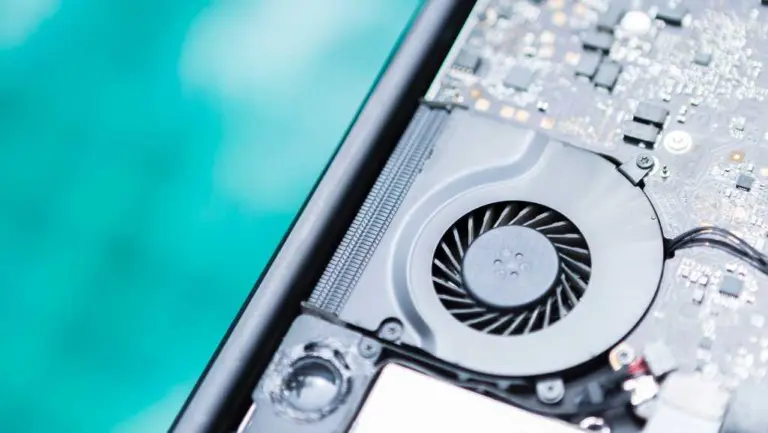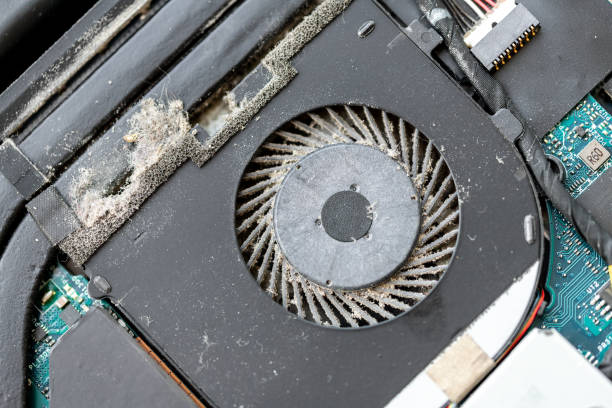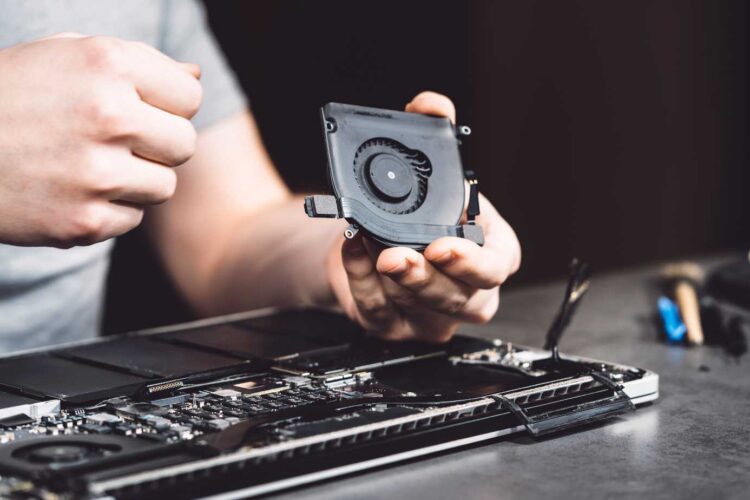
Ultimate Guide To Fix HP Laptop Cooling Fan Not Working
When your HP laptop’s cooling fan is not working, it can lead to overheating issues that may affect the performance and lifespan of your device.

When your HP laptop’s cooling fan is not working, it can lead to overheating issues that may affect the performance and lifespan of your device. In this comprehensive guide, we will explore common signs of a malfunctioning cooling fan, initial troubleshooting steps, cleaning techniques, software solutions, and settings adjustments to help you fix the laptop fan issue and prevent further damage to your laptop.
When your HP laptop starts making noises that are out of the ordinary, it’s a clear signal that the cooling fan might be struggling. Listen for grinding, rattling, or buzzing sounds, as these are indicative of a fan that could be obstructed or failing.
It’s crucial to address these noises promptly. Ignoring them can lead to overheating, which may cause irreversible damage to your laptop’s internal components.
If your HP laptop feels hot to the touch, this is a clear indicator that the cooling fan may not be functioning properly. Excessive heat can lead to hardware damage and reduce the lifespan of your device.
It’s crucial to address overheating issues promptly to prevent long-term damage to your laptop.
Remember, a laptop that’s too hot to handle is more than just a minor inconvenience; it’s a symptom of a potentially serious problem.
If your HP laptop is experiencing frequent system shutdowns, it could be a sign that the cooling fan is failing to regulate the device’s temperature effectively. This is not only a nuisance but can also lead to data loss or hardware damage if not addressed promptly.
It’s crucial to take immediate action if you suspect overheating is causing your laptop to shut down. Ignoring this issue can result in permanent damage to your laptop’s components.
Remember, overheating can lead to loss of important files. In such cases, after resolving the overheating issue, use a reliable data recovery software to retrieve any lost data.

Over time, dust and debris can accumulate in your laptop’s cooling fan, which can impede its performance and lead to overheating. Regularly checking for dust buildup is a crucial maintenance step to ensure your laptop’s longevity and functionality.
To inspect the fan, you will need to locate it within your laptop. This usually involves removing the bottom panel of your laptop’s casing. Once you have access to the fan, use a soft, lint-free cloth to gently wipe away any visible dust. For stubborn dust particles or areas that are difficult to reach, consider using compressed air to blow the dust away.
Remember, it’s important to be gentle when cleaning the fan. Excessive force can damage the fan blades or other components.
If you encounter any adhesive or components that seem to be glued in place, be cautious. As suggested by Lifewire in their guide on how to clean a laptop fan, you may need to use a heat source to loosen any glue before proceeding.
Proper ventilation is crucial for maintaining an optimal operating temperature for your HP laptop. Ensure that the laptop’s air vents are not blocked by objects such as books, papers, or cloth materials. This can restrict airflow and contribute to overheating issues.
It’s important to regularly check the space around your laptop’s vents. Even small obstructions can significantly impact the cooling efficiency, leading to potential overheating.
Ensuring that the cooling fan in your HP laptop is receiving power is a critical step in diagnosing overheating issues. Check the laptop’s BIOS settings to verify that the fan is enabled and review the power supply connections to the fan. If the fan is not listed or if there are any error messages related to the fan, it may indicate a power supply or hardware issue.
If the fan still does not work after verifying the connection, the issue may lie with the fan unit itself or the motherboard’s power circuitry. Consider seeking professional assistance if you are not comfortable with advanced troubleshooting.
Before attempting to clean your HP laptop’s cooling fan, it’s essential to have the right tools at hand. Gathering the necessary supplies will ensure that you can proceed safely and effectively, without causing damage to your laptop’s internal components.
Remember, using the correct cleaning supplies can prevent static buildup and potential harm to your laptop’s delicate parts. Always opt for tools that are specifically designed for electronic devices.

Before proceeding to clean the cooling fan, it’s crucial to ensure the laptop is completely powered off. Disconnect all cables and peripherals to avoid any electrical hazards or damage to the components. After shutting down your HP laptop, wait for all lights to turn off, indicating that the device is no longer in any power state, such as sleep or hibernation.
Next, you’ll need to access the internal components where the cooling fan is located. This typically involves removing screws from the bottom of the laptop and carefully separating the bottom cover or keyboard deck from the main chassis. It’s important to keep track of the screws and their respective locations:
Remember, patience and attention to detail are key when disassembling your laptop. Rushing through this process can cause irreversible damage to your device.

Once you have disassembled your HP laptop and located the cooling fan, it’s time to proceed with caution. Ensure the laptop is completely powered off and unplugged before attempting to clean the fan blades. Use a can of compressed air to gently blow away any loose dust or debris. For stubborn grime, a cotton swab lightly dampened with isopropyl alcohol can be used to carefully wipe the blades.
Remember, the goal is to remove dust without causing any damage to the fan or other components. Apply minimal pressure and let the cleaning agents do the work.
If your fan has a removable dust filter, take this opportunity to clean it as well. A clean filter will significantly improve airflow and cooling efficiency. After cleaning, ensure everything is dry before reassembling your laptop.
Keeping your laptop’s drivers up-to-date is crucial for ensuring that all components, including the cooling fan, operate efficiently. Outdated drivers can lead to hardware malfunctions, which might be the cause of your cooling fan’s issues. To update your HP laptop’s device drivers, follow these steps:
It’s also worth noting that some users have reported issues with the HP Command Center software, which is designed to manage various aspects of your laptop’s performance, including cooling. If you’re experiencing overheating problems, consider checking for updates or reinstalling this software as well.
Regular driver updates can prevent many hardware issues and improve your laptop’s overall performance.
Adjusting your HP laptop’s power settings can have a significant impact on its cooling efficiency. By selecting a power plan that is optimized for energy saving, you can reduce the workload on your laptop’s processor and, consequently, the amount of heat it generates. This can help prevent overheating and reduce the need for the cooling fan to work as hard.
Remember, while adjusting power settings can help manage heat, it should not compromise the laptop’s performance for your needs. Find a balance that maintains efficiency without overheating.
In addition to software and settings adjustments, using a cooling pad or stand can significantly help in reducing your HP laptop’s temperature. These accessories facilitate better air circulation and can be particularly beneficial for gaming laptops, which are prone to overheating due to high-performance components.
It’s important to choose a cooling pad or stand that matches the size and airflow requirements of your laptop to ensure optimal cooling efficiency.
In conclusion, addressing issues when an HP laptop’s cooling fan is not working is crucial to prevent overheating and potential damage to the device. By understanding the importance of cooling fans, recognizing common signs of fan failure, and following the troubleshooting steps outlined in this guide, users can effectively maintain the optimal performance of their laptops. Whether it involves cleaning the fan, updating the BIOS, or seeking professional help for repair, taking proactive measures is essential for ensuring the longevity of the laptop. Remember, a well-functioning cooling fan is key to the overall health and functionality of an HP laptop.
Common signs include unusual noise coming from the laptop, the laptop feeling hot to the touch, and frequent system shutdowns.
Check for dust buildup in the fan and ensure proper ventilation to prevent overheating.
Yes, you can clean the cooling fan by turning off and disassembling the laptop, then carefully cleaning the fan blades with the necessary supplies.
You can update device drivers through the Device Manager in Windows or by downloading the latest drivers from HP’s official website.
Yes, using a cooling pad or stand can help improve airflow and reduce the temperature of your laptop during use.
Consider replacing the cooling fan if cleaning and troubleshooting do not resolve the overheating issues, or if the fan is making loud or unusual noises.
If you’re facing issues with your HP laptop’s cooling fan not working in Singapore, it’s crucial to address the problem promptly to avoid overheating and potential damage to your laptop’s components. A reliable place to get this issue fixed, as well as to seek advice on upgrades and repairs, is Volta PC Upgrade & Repair.
Expertise in HP Laptops: Volta PC Upgrade & Repair has a team of skilled technicians who are experienced in dealing with HP laptops. Whether it’s a cooling fan issue or any other problem, they can diagnose and fix it efficiently.
Comprehensive Services: Beyond cooling fan repairs, Volta offers a wide range of services including hardware upgrades (like SSDs and RAM), software troubleshooting, and general maintenance. This makes it a one-stop solution for all your laptop needs.
Quality Parts: They use high-quality, genuine parts for replacements, ensuring that your laptop performs well and remains reliable over time.
Warranty on Repairs: To give you peace of mind, Volta PC Upgrade & Repair provides warranties on their repairs.
Competitive Pricing: Their pricing is transparent and competitive, offering good value for the quality of service and parts they provide.
Customer Reviews: Before making a decision, consider looking up online reviews or testimonials about Volta PC Upgrade & Repair. Customer feedback can give you insight into their service quality and customer satisfaction.
To get your HP laptop’s cooling fan fixed or to inquire about upgrades and repairs, you can visit their official website or contact them directly through their customer service line. It’s advisable to book an appointment or consult with them about your laptop’s issues before visiting to ensure you receive prompt and efficient service.

When your HP laptop’s cooling fan is not working, it can lead to overheating issues that may affect the performance and lifespan of your device.

Welcome to our comprehensive blog post on ‘How to Test Your Laptop Fan.’ In today’s fast-paced digital world, your laptop is more than just a

Trying to fix loud laptop fan is a common concern for many laptop users. These devices, essential for work, education, and entertainment in the digital